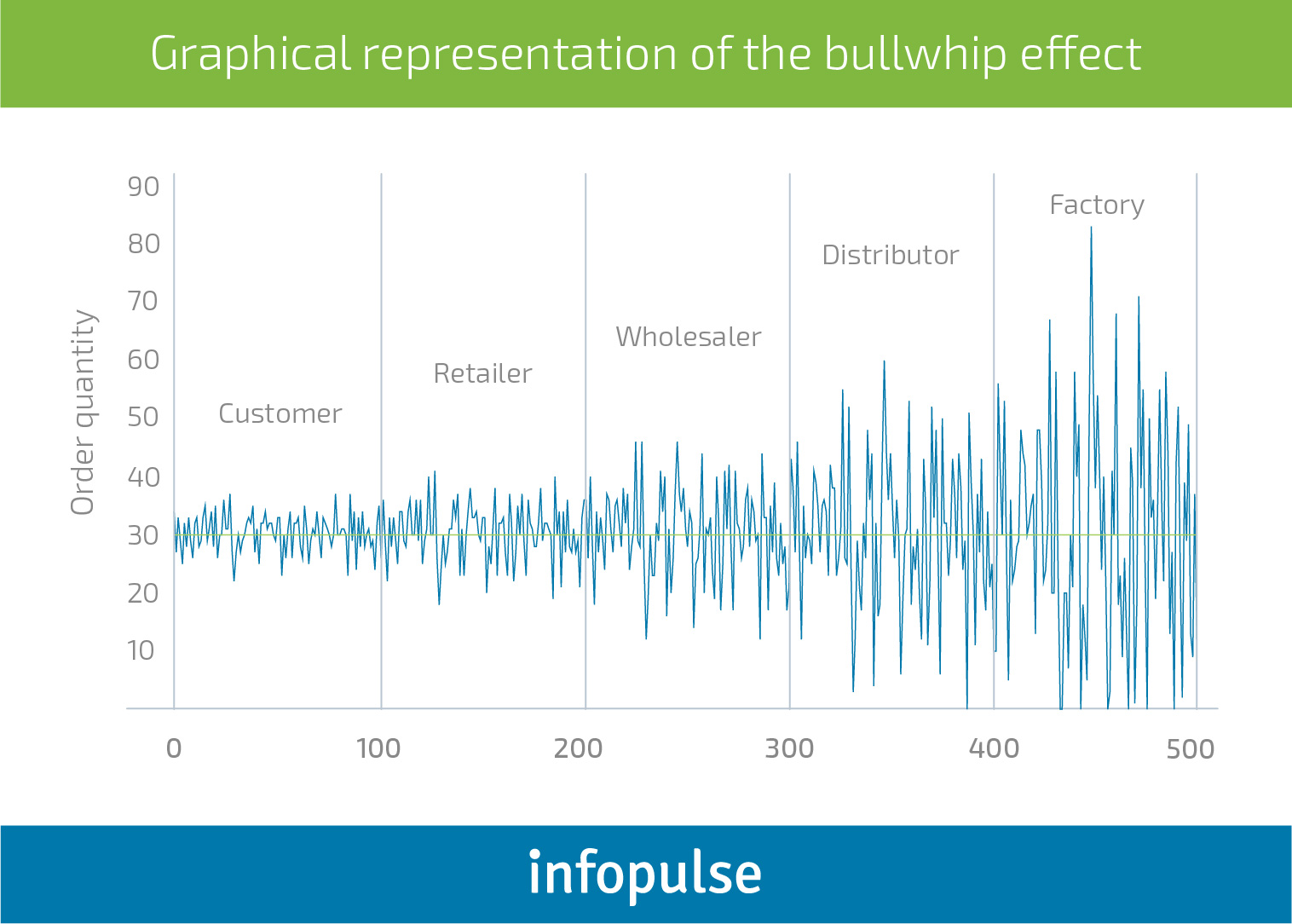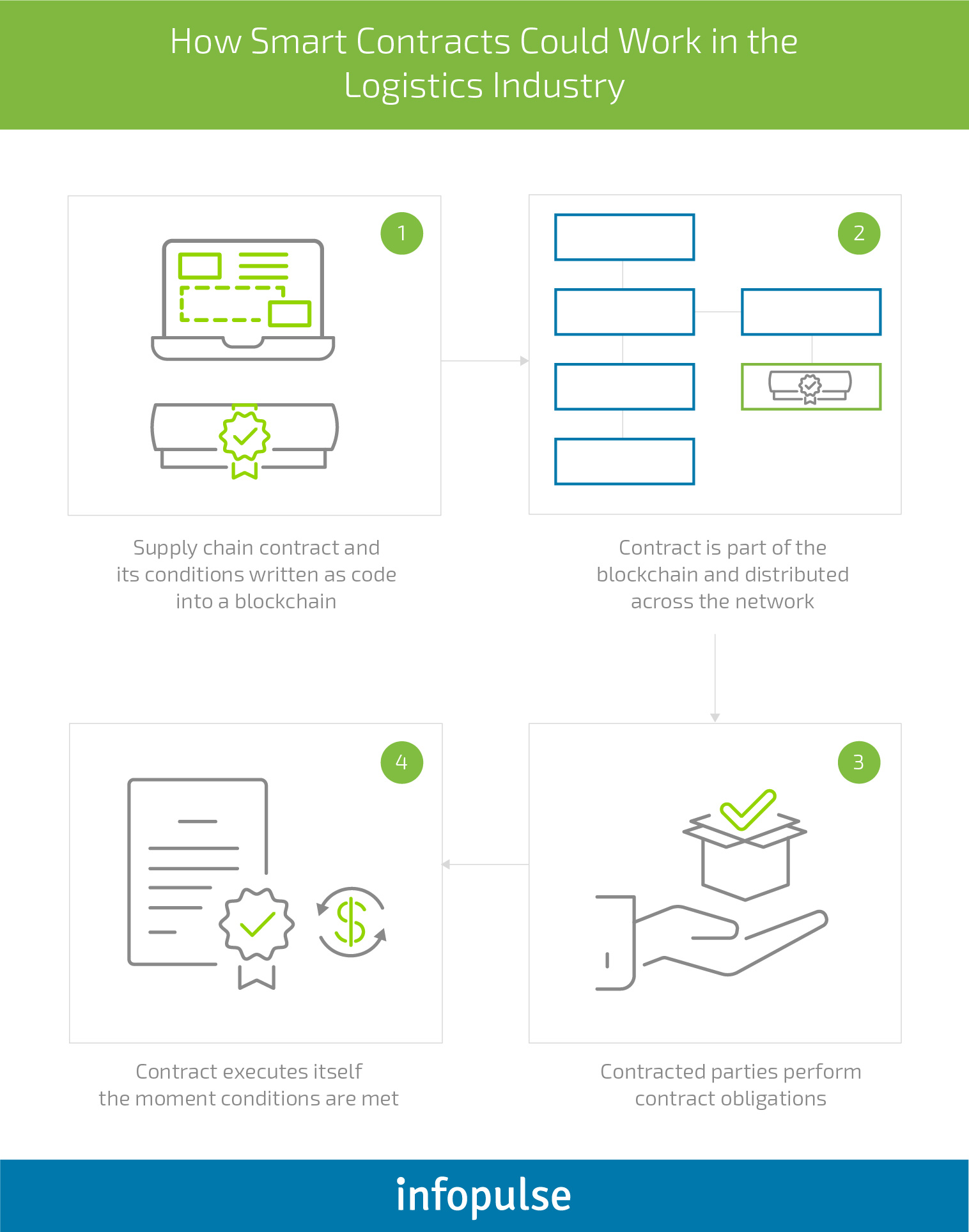How Can Cloud Computing and Blockchain Reduce the Bullwhip Effect in Supply Chain?
In 2018, 21% of supply chain managers named “visibility” as their biggest organizational obstacle. The number may not seem significant. But just a year before that, only 12% mentioned visibility among the top challenges. This should come as no surprise considering that an average company now needs to pass 52 pieces of data across the supply chain. And traditional ERP or SCM (Supply Chain Management) systems can no longer cope with managing so much information.
As a result of limited data processing capabilities and lack of collaboration within a supply chain, a major issue emerges – the bullwhip effect.
What is the Bullwhip Effect and How It Manifests in Supply Chain Management
The bullwhip effect refers to an occurrence, taking place in the supply chain. This effect takes place when the demand at the downstream end (customer/retailer) causes larger variance at the upstream (factory/manufacturing facility).
In short, the slow-moving customer demand can create significant swings in production for the supplier at the opposite end of the supply chain.

As the image above illustrates, irregular orders placed by the lower part of the supply chain can create massive disturbances in production further up, and undermine supply chain efficiency. Due to this effect, different entities in the supply chain will over- or underestimate the original product demand, and further agitate the fluctuations.
P&G was among the first businesses to coin the definition of the “bullwhip” effect in the supply chain in the 90s. When examining the order patterns for their top-selling products – Pampers, the company’s logistics executives noticed some mild sales fluctuations in retail stores, which were not that significant. When taking a closer look at the distributors’ orders, the team uncovered a much larger degree of variability. Further, they examined P&G’s orders of materials from their suppliers and noticed even higher swings. At first, the emerged pattern didn’t make any sense. After all, the consumer demand remained steady. However,
the demand order variabilities in the supply chain increased as those variabilities moved up the supply chain.
In order to better understand what the bullwhip effect in supply chains is, it’s worth looking into its consequences for businesses.
How the Bullwhip Effect Impacts the Supply Chain
When distorted information is transmitted up the supply chain, at some point the cost from those fluctuations in production/ordering can outweigh the cost of holding inventory, resulting in a major revenue drain for businesses. Recent research suggests that a decrease in the bullwhip effect ratio by one can generate $26 in inventory cost savings, as well as a stockout reduction of 0.15 days for a product during a year. Proactively taking this effect with different bullwhip techniques can further enhance the overall supply chain performance and foster service-level improvements.
The bullwhip effect plaguing your supply chain can manifest itself in the following manners:
- Inaccurate product forecasting
- Excessive inventory
- Insufficient or excessive capacities
- Increased customer service issues due to out-of-stock products or long backlogs
- Gaps in production planning (i.e., excessive revisions)
As you can see, the consequences of the bullwhip effect can be immensely tangible for businesses. However, to find a suitable bullwhip effect solution for your business, you’ll first need to understand where this effect stems from. A range of factors can contribute to the bullwhip effect for companies in different industries:
- Sub-par supplier/customer relationships and immature processes, resulting in disorganization between different links in the supply chain.
- Ineffective demand forecasting: relying on outdated demand information to make forecasts can contribute to higher supply chain disturbance.
- Mediocre production organization with machines being set up and shutting down at non-optimal times, resulting in either idling or overtime work.
- Order batching: the practice of accumulating the demand before sending an order to the supplier can create unfavorable irregularities.
- Price variations. Lack of organization-wide pricing strategy (with deals and discounts issued randomly) can create havoc in the regular buying patterns and cause uneven production and distorted demand information.
How to Reduce the Bullwhip Effect with Cloud Computing
Two new technologies have emerged as strong contenders for addressing (and ultimately eliminating) the major causes of the bullwhip effect in digital supply chains.
Cloud computing is an enabler for businesses to deploy new solutions for optimizing infrastructure, platform and software services delivery for the whole supply chain network via the Internet. Using cloud computing more links within your supply chain can be digitized – supplied with real-time data, better connectivity and improved data sharing tools for all supply chain participants. It’s the first necessary step to improve supply chain visibility and velocity. Gartner estimates that in just one year, over 90% of the spending on supply chain execution systems will be for cloud supply chain solutions. Clearly, your competitors are already “gearing up”.
Implementing a cloud-based platform can help your business better coordinate all the chain’s participants and gather more accurate data from them for demand forecasting. By relying on cloud computing architecture, you can eliminate data inconsistencies and gather more accurate intel for forecasting/planning. For instance, you can create a system to automatically collect shipping information, the status of the order and other information from suppliers, as well as sharing updates on future demand. Using predictive analytics, your company can then make more accurate estimates and anticipate shortages (for instance, by analyzing shortage data from the past 2-3 seasons) and creating predictions for what items may sell best. These updates can be transmitted further down the chain so that all parties can adjust their operations and avoid disruptions. Keep in mind that today 74% of companies are already talking with their key suppliers about new business continuity arrangements.
In addition, cloud computing allows businesses to proactively tackle the quality of shared information – another major aspect of reducing the bullwhip effect in linear supply chains. Specifically, cloudifying your SCM systems will allow you to ensure that every participant of the supply chain receives the right information, at the right place and at the right time. Improved collaboration is extremely important in the current landscape. According to PwC, 74% of companies state that the number of participants in the supply chain has increased in the past 3 years. At the same time, 95% mention that the discrepancies between supply chain entities have increased as well. Legacy systems cannot seamlessly accommodate such rapid growth and active addition of new links, but cloud platforms can be configured to scale rapidly and “plug in” those new participants.
As a result, communication and collaboration in supply chains can be improved on three distinctive levels:
Level 1: Transaction integration. This step involves automating common business processes and transactions using cloud platforms and tools. As a result, all supply chain entities can exchange the following types of data:
- Purchase orders, work orders, and sales orders
- Invoices
- Credit and debit notes
- Payments
Bonus point: You can achieve an even greater level of financial data management automation with RPA (robotic process automation).
Level 2: Supply chain management information sharing. Digitized supply chain gives all entities access to better information for decision making. To enable the latter, the following data can be shared both up and down the supply chain:
- Production or component forecasts
- Production and transportation/shipping plans and capacities
- Product and material availability
- Bills of material (BOMs)
- Orders
- Prices and promotions
- Inventory
- Service levels
- Contract terms, such as supply capacity, inventory, etc.
Level 3: Strategic collaboration. Once your system is up and running smoothly, you can participate in joint planning, process redesign, and further collaborative process optimization to further improve your supply chain management. Together with other participants, you can make collaborative decisions on the following:
- Enhancing strategic supply chain relationships and profitability
- Upgrading forecast accuracy
- Leveling up sales and operations planning
- Resolving critical supply chain events at a faster pace
- Creating unified pricing plans
- Accelerating and managing demand plans, direct material procurement and fulfillment throughout the supply chain
- Improving production capacities and working out an effective fulfillment network expansion
Unlocking this additional knowledge results in significant benefits for businesses:
- Lower inventory levels and increase inventory turns
- Reduced transportation and warehousing costs
- Shortened lead times
- Greater visibility into customer demand and supplier performance
- Slashed out-of-stock levels
- Improved customer service metrics
Case in point: Garmin has carried out two specific IT initiatives to mitigate the bullwhip effect. Firstly, the company integrated its internal information repositories, as well as centralized relevant forecast and transactional information. The second initiative was aimed at improving integration and information sharing among the external partners in the supply chain with the help of cloud computing technology.
Cloud-based information systems have helped the company reduce price variations and rationing game strategy, and in this way reduce the bullwhip effect. They have created an effective business process for collecting and reconciling information from within and outside the company, and, as a result, generate a single projection of demand. Such improved information sharing and collaboration have boosted the supply forecast accuracy.
Addressing Information Asymmetry with Blockchain
However, cloud computing is not the only strong technological candidate for improving information exchanges and collaboration within the supply chain. Blockchain can be used to tackle information asymmetry on a wider scale.
As a secure digital ledger, the blockchain component can act as a single, unified source of data and enable real-time access to all the records, as well as seamless and automated updates. Several studies have proved that the bullwhip effect can be reduced when additional information is being shared with all parties such as:
- Inventory levels
- Work in progress levels
- Order data
- Demand data
When these insights are available, all entities can base their forecasts on the same data, thus reducing those swings in production further down the supply chain.
The issue here, however, is that all those insights are highly sensitive. For instance, exchanging demand data vertically (upstream or downstream the supply chain) often means revealing personal customer information (e.g. names). Additionally, some organizations will need to share the same data horizontally with parties at the same level of the supply chain or with other supply chains. Some industries are also bound by additional regulations – taking additional security measures such as anonymization thus becomes imperative.
Blockchain technology can help accomplish just that. All the entries codified on the digital ledger are cryptographically protected, making the data virtually impossible to breach. Additionally, customer records do not change hands per se. Instead, every participant is given key access to the data stored on the ledger. Opting for such architecture means that customers can retain access to their private data and only choose to grant access to it.
An additional advantage of using blockchain for supply chain management is improved visibility. When a downstream party adds new data, the upstream actors will immediately have the same level of access to it, regardless of the number of other entities in between.
What’s more, blockchain can be used to codify and automate the execution of various contracts with supply chain entities. A smart contract is a codified agreement that self-executes when specific conditions are met. For instance, once the payment is cleared, a supplier will automatically ship the ordered products. Smart contracts do not require any intermediaries and yet can increase the accountability of each party responsible for making certain actions by defining the rules and enforcing penalties if either of the parties breaches the contract terms.

Furthermore, smart contracts reduce errors and inefficiencies in financial data exchanges, improve the settlement process including trade finance and assist with the resolution of disputes when it comes to logistics. Per Accenture, 10% of all freight invoices come with inaccurate data, which leads to disputes, overpayments, and disruptions. Smart contracts can eliminate these issues.
In addition, when blockchain is combined with IoT, supply chain contracts can be upgraded even further. IoT sensors can capture and record additional parameters about transportation conditions (e.g. temperature, humidity, tilt levels, etc.) and release the payment only if the goods were delivered according to the pre-agreed conditions.
Ultimately, blockchain technology has several major advantages when it comes to improving supply chain management.
- It enables faster transactions by:
- reducing the time needed for receiving confirmations from multiple entities;
- providing verified, reliable information whenever it is needed;
- enabling a certain extent of the transaction logical automation through smart contracts.
- It provides unified access to multiple sources of information to different decision makers. Unlike other technologies (mobile apps, cloud computing, proprietary networked systems) blockchain has a lower cost of adding new participants to the system. Besides, it comes with better data encryption and records validation mechanisms to ensure data accuracy and consistency.
- It enhances collaboration among the supply chain participants through tokenization. Verifiable digital claims (tokens) can be created to correspond to various production-, inventory-, and financial assets. These assets can be seamlessly shared, traded and exchanged among the network participants. Tokenization improves coordination within the extended supply and distribution chains (virtual vertical integration) and the coordination of actions of entities at the same level (virtual horizontal coordination). As a result, contracting B2B and B2C interactions can be codified and become less expensive from the legal and transactional perspective.
- Finally, blockchain allows selective information aggregation, where only the required information for improving supply chain efficiency is shared, while sensitive data (such as customer identities) is not.
All of these features together position blockchain as a powerful solution to reducing the bullwhip effect, enabling higher visibility and greater collaboration in supply chain management.
Conclusion
The bullwhip effect is challenging to discover, and even more complex to mitigate. New technologies such as cloud computing and the blockchain have recently emerged as strong contenders for this task. Both power better information exchanges and coordination within complex supply chains – the key elements for reducing the impact of the bullwhip effect on your operations.
If you are ready to digitize your supply chain, get in touch with Infopulse. Our blockchain specialists and cloud experts can match your business needs with the best technological solutions. Get in touch today.


![CX with Virtual Assistants in Telecom [thumbnail]](/uploads/media/280x222-how-to-improve-cx-in-telecom-with-virtual-assistants.webp)
![Generative AI and Power BI [thumbnail]](/uploads/media/thumbnail-280x222-generative-AI-and-Power-BI-a-powerful.webp)
![AI for Risk Assessment in Insurance [thumbnail]](/uploads/media/aI-enabled-risk-assessment_280x222.webp)
![Super Apps Review [thumbnail]](/uploads/media/thumbnail-280x222-introducing-Super-App-a-Better-Approach-to-All-in-One-Experience.webp)
![IoT Energy Management Solutions [thumbnail]](/uploads/media/thumbnail-280x222-iot-energy-management-benefits-use-сases-and-сhallenges.webp)
![5G Network Holes [Thumbnail]](/uploads/media/280x222-how-to-detect-and-predict-5g-network-coverage-holes.webp)

![How to Reduce Churn in Telecom [thumbnail]](/uploads/media/thumbnail-280x222-how-to-reduce-churn-in-telecom-6-practical-strategies-for-telco-managers.webp)
![Automated Machine Data Collection for Manufacturing [Thumbnail]](/uploads/media/thumbnail-280x222-how-to-set-up-automated-machine-data-collection-for-manufacturing.webp)
![Money20/20 Key Points [thumbnail]](/uploads/media/thumbnail-280x222-humanizing-the-fintech-industry-money-20-20-takeaways.webp)